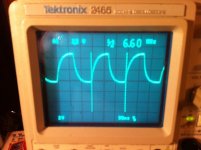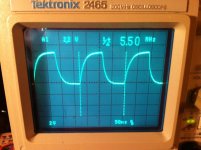dkedrowitsch
Experienced Member
I've had this motherboard for years and it worked perfectly when I got it. Unfortunately I never got around to building a system with it until trying this week, but to my disappointment it's now dead as a door-nail.
It's one of those neat little boards about the size of a CD-ROM drive, with 6 ISA slots and a newer looking 486 style chipset. It also has 256K of cache on board, which is huge for a 386. The system clock is jumper selectable for 33Mz or 40MHz, and the board uses a clock generator rather then being fixed to a single frequency with a traditional oscillator.
The battery did leak and did a little bit of damage but not as bad as I usually see...just a little discoloration of some of the traces and via around the battery. A few years ago I removed the battery to keep it from getting any worse and the board still worked fine at the time. Today I checked all of the traces and vias around the battery area and everything checks out OK. Some of the vias were iffy looking but a strand of wire pushed through and soldered on either side made sure they're fine.
Upon powering up I get no beep from the speaker with or without RAM or a video board installed.
Neither the BIOS ROM or Keyboard 8042 ICs were socketed, so I removed them and added sockets to easier troubleshoot. The BIOS and 8042 tested good in another 386 board. For good measure I programmed an eprom with an AMIBIOS 386 binary and tried a different 8042 chip but no change. I also tried a different set of cache chips as well as leaving them out altogether. Same thing, no beep, no video...nothing.
I reflowed the TQFP chipset ICs with a little flux and my hot-air station to make sure there were no contact problems there, but that hasn't helped either.
I've verified the system clock generator produces 80MHz (66.6 when motherboard jumpered for 33MHz) and I do see the ISA clock signal on ISA bus pin B20, but it's not the right frequency. I should see an 8.3MHz clock signal there but instead I see 6.6MHz when the board is jumpered for 40MHz sysclock, and 5.5MHz when jumpered for 33MHz sysclock. Is this normal? An older Micronics 386 board I just tested has a 8.3MHz ISA clock signal like I would expect, so this little board is acting weird to me.
When watching some of the address and data lines on the ISA bus with my scope I do see signs of life for a second or two on power-up, but then nothing. I wish I had a logic analyzer...
I just ordered an ISA post diagnostic card to arrive, so once that comes hopefully I can use that to get an idea of where the post is hanging up. The problem must be early in the sequence since I never get anything from the speaker.
Anyway, I've probably spent way too much time on this already, but I'm determined to invest a little more before giving up. I looked on eBay to see if there are any other boards like it and there are, but as usual they're from "recyclers" and the prices are insane.
I'm attaching pictures of the ISA clock signals...they look pretty crummy even on my 100Mz probe but I think my probe just needs adjusting.
Assuming the funny ISA clock may be normal for this board, I figure either the CPU is bad, or one of the two chipset ICs is bad. I guess one of the ISA bus transceivers could also have gone bad, but I doubt that would cause even early post failure...I would still at least hear some beeping, right?
Any ideas or suggestions? Is the funky ISA clock speed normal for some boards, or should I investigate the source of that signal further?


It's one of those neat little boards about the size of a CD-ROM drive, with 6 ISA slots and a newer looking 486 style chipset. It also has 256K of cache on board, which is huge for a 386. The system clock is jumper selectable for 33Mz or 40MHz, and the board uses a clock generator rather then being fixed to a single frequency with a traditional oscillator.
The battery did leak and did a little bit of damage but not as bad as I usually see...just a little discoloration of some of the traces and via around the battery. A few years ago I removed the battery to keep it from getting any worse and the board still worked fine at the time. Today I checked all of the traces and vias around the battery area and everything checks out OK. Some of the vias were iffy looking but a strand of wire pushed through and soldered on either side made sure they're fine.
Upon powering up I get no beep from the speaker with or without RAM or a video board installed.
Neither the BIOS ROM or Keyboard 8042 ICs were socketed, so I removed them and added sockets to easier troubleshoot. The BIOS and 8042 tested good in another 386 board. For good measure I programmed an eprom with an AMIBIOS 386 binary and tried a different 8042 chip but no change. I also tried a different set of cache chips as well as leaving them out altogether. Same thing, no beep, no video...nothing.
I reflowed the TQFP chipset ICs with a little flux and my hot-air station to make sure there were no contact problems there, but that hasn't helped either.
I've verified the system clock generator produces 80MHz (66.6 when motherboard jumpered for 33MHz) and I do see the ISA clock signal on ISA bus pin B20, but it's not the right frequency. I should see an 8.3MHz clock signal there but instead I see 6.6MHz when the board is jumpered for 40MHz sysclock, and 5.5MHz when jumpered for 33MHz sysclock. Is this normal? An older Micronics 386 board I just tested has a 8.3MHz ISA clock signal like I would expect, so this little board is acting weird to me.
When watching some of the address and data lines on the ISA bus with my scope I do see signs of life for a second or two on power-up, but then nothing. I wish I had a logic analyzer...
I just ordered an ISA post diagnostic card to arrive, so once that comes hopefully I can use that to get an idea of where the post is hanging up. The problem must be early in the sequence since I never get anything from the speaker.
Anyway, I've probably spent way too much time on this already, but I'm determined to invest a little more before giving up. I looked on eBay to see if there are any other boards like it and there are, but as usual they're from "recyclers" and the prices are insane.
I'm attaching pictures of the ISA clock signals...they look pretty crummy even on my 100Mz probe but I think my probe just needs adjusting.
Assuming the funny ISA clock may be normal for this board, I figure either the CPU is bad, or one of the two chipset ICs is bad. I guess one of the ISA bus transceivers could also have gone bad, but I doubt that would cause even early post failure...I would still at least hear some beeping, right?
Any ideas or suggestions? Is the funky ISA clock speed normal for some boards, or should I investigate the source of that signal further?


Last edited:
